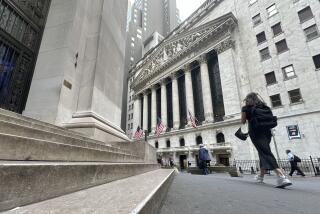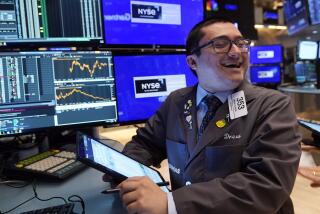Stocks Plummet as Dollar Reels : 57-Point Drop Is Dow Index’s 3rd-Worst Day
NEW YORK — Panic buffeted the stock market Monday as investors, reacting to new trade tensions with Japan and the dollar’s steep descent, went on a selling spree that sent the Dow Jones industrial average into a harrowing 80-point nose dive during the session’s first 40 minutes and handed the bull market its sharpest setback of the year.
The closely monitored Dow Jones average of 30 blue-chip stocks never recovered from the violent drop at the opening bell and finished the day at 2,278.41, down 57.39 points, in heavy trading.
It was the Dow’s third-steepest drop for a single day ever, but it amounted to only 2.5% of the value of the average compared to the historic 12.9% drop of 38.33 points on Oct. 28, 1929.
Biggest Since September
Monday’s plunge was the biggest decline of the index since its record 86.61-point, 4.6% plunge last Sept. 11. The second-largest drop in the history of the average--61.87 points, or 3.3%--took place last July 7.
Traders and analysts were sharply divided over whether Monday’s losses, which extended a wave of selling that sent the Dow skidding 36.79 points on Friday, threaten to derail one of the strongest quarterly market advances ever.
In the last three months, the Dow has gained 476.64 points--compared to its 375-point gain for all of 1986, also a strong year for the stock market--prompting some to caution that the market is overextended and a major reversal is in the offing.
Michael Metz, market strategist for the Oppenheimer & Co. brokerage, predicted that the abrupt decline has “broken the momentum of the bull market” and warned that if Japanese investors continue to shun U.S. stocks as he said they did Monday, the result would be “absolutely lethal.”
But Lawrence Wachtel, a market strategist for Prudential-Bache Securities, said he thinks the market is just taking a breather. “When a market moves in the kind of quantum leaps this one has, the corrections are going to be quantum too,” he said, predicting that it will withstand this loss just as it did the 110-point plunge during a 90-minute stretch on Jan. 23.
Interest-Rate Fears
Market specialists said the steep decline was caused by investors’ fresh fears of rising interest rates and a new round of inflation--fallout, they said, from the renewed decline in the value of the dollar compared to other currencies and from the Reagan Administration’s move last week to impose trade sanctions on Japan for the first time since World War II.
“Investors have been looking for a reason to sell and they found it,” Metz said. “They fear that this brouhaha with the Japanese will have inflationary consequences.”
The theory is that Reagan’s decision to place tariffs on such Japanese goods as color television sets and personal computers will have the unintended effect of raising U.S. consumer prices, thus triggering another round of inflation.
The continuing descent of the dollar, which dropped to a new low against the yen in Tokyo and also fell against other major currencies, fed fears that as the U.S. currency declines in value the cost of imports will rise here.
Bond Prices Tumbling
A declining dollar also causes foreign investors to shun U.S. debt securities, which is why bond prices have been tumbling recently. This, in turn, causes interest rates to rise because yields must rise to attract new investors.
The bond market was further aggravated Monday because “the Japanese have been major supporters of our bond market and they’re not going to do us any favors right now,” noted Gene Seagle, a market analyst at the Gruntal & Co. brokerage.
There were similar sell-offs on world markets Monday. Investors cited fear that U.S. tariffs on Japanese semiconductors--the tiny silicon chips used in computers and many other electronic products--could lead to a full-scale trade war and corresponding damage to other nations’ economies. Tokyo’s market was particularly hard hit, with stocks falling 550.45 points to close at 21,627.57, that index’s second-largest drop ever.
Openings Delayed
The selling frenzy on the New York Stock Exchange began as soon as the market opened. There were so many orders to sell in the first few minutes--particularly from overseas buyers--that the opening of many stocks was delayed.
By mid-day, the Dow had recaptured about half of its initial 80-point drop and then hovered around the minus 50-point mark most of the day.
In all, 208.44 million shares changed hands on the Big Board, compared to 184.4 million shares Friday.
As “eye catching” as the initial 80-point drop, Wachtel said, was the broad swath the sell-off cut through the stock market. On the New York Stock Exchange, price-losing stocks overpowered advancing issues by 7 to 1 and the margin was twice that earlier in the day, indicating “an unusually broad-based sell-off,” Wachtel said.
Other Indexes Fall
The Standard & Poor’s 500-stock index, a much broader market measure than the Dow, also fell sharply--by 6.92 points to 289.21. The New York Stock Exchange Composite Index likewise fell 3.81 to 164.56. And the Dow Jones transportation average fell 20.23 to 915.21, its third-largest decline ever.
Prices on the American Stock Exchange also closed sharply lower--down 6.94 to 331.17.
More to Read
Inside the business of entertainment
The Wide Shot brings you news, analysis and insights on everything from streaming wars to production — and what it all means for the future.
You may occasionally receive promotional content from the Los Angeles Times.










